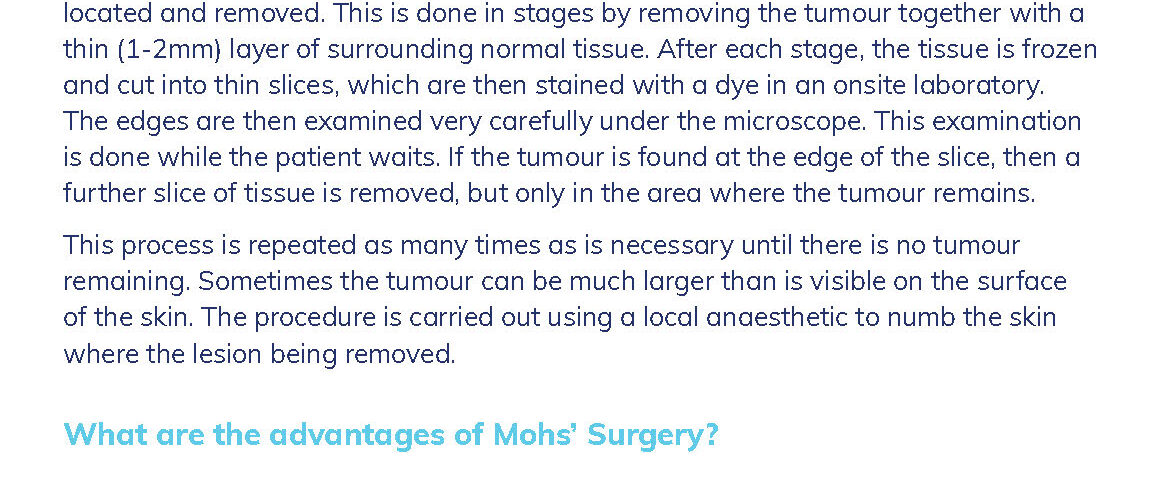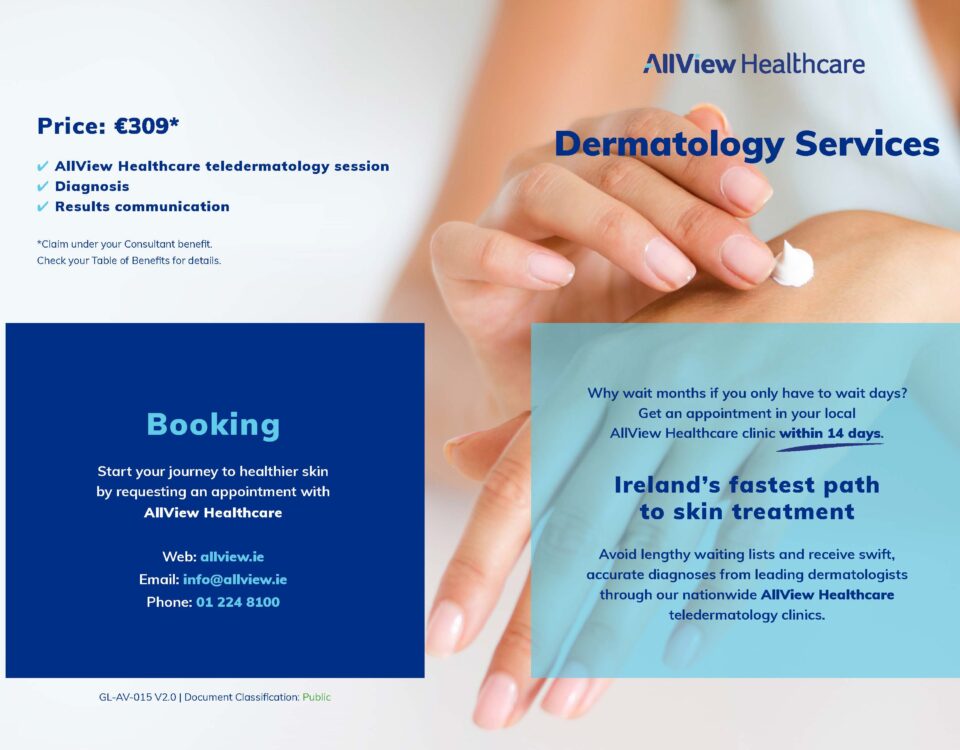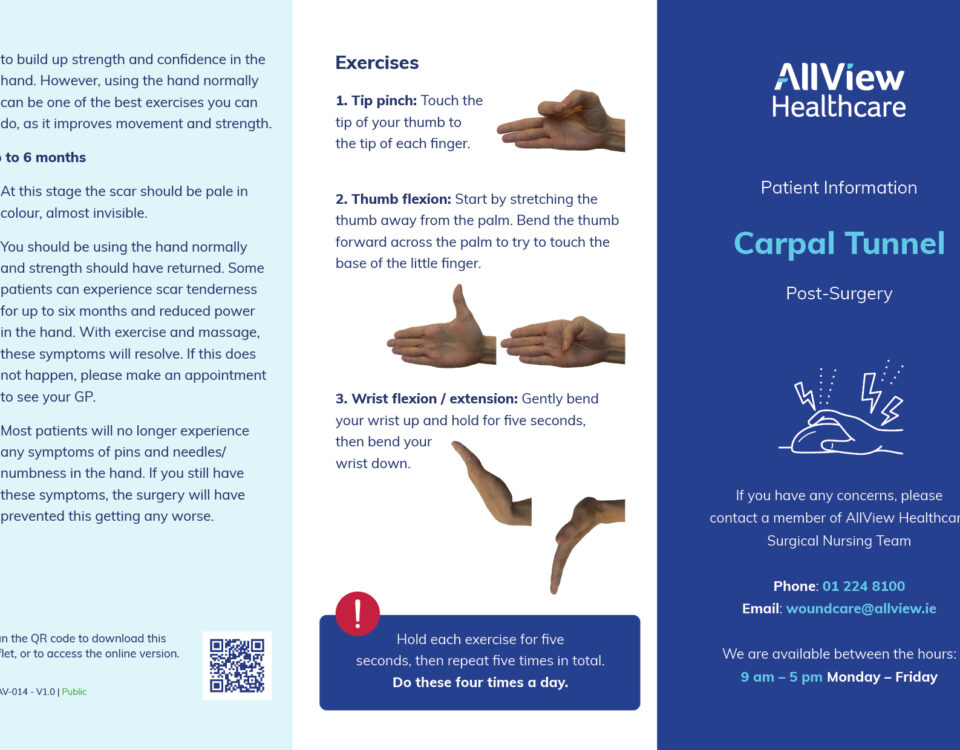Mohs’ Micrographic Surgery

Patient Information
Mohs’ Micrographic Surgery
What is Mohs’ micrographic surgery?
Mohs’ micrographic surgery was first developed by Dr Frederic Mohs in the 1930s. It is a specialised surgical method for removing certain types of skin cancer – usually basal cell cancers (BCC) and squamous cell cancers (SCC).
During the Mohs’ micrographic surgery procedure, the ‘roots’ of the skin cancer are located and removed. This is done in stages by removing the tumour together with a thin (1-2mm) layer of surrounding normal tissue. After each stage, the tissue is frozen and cut into thin slices, which are then stained with a dye in an onsite laboratory. The edges are then examined very carefully under the microscope. This examination is done while the patient waits. If the tumour is found at the edge of the slice, then a further slice of tissue is removed, but only in the area where the tumour remains. This process is repeated as many times as is necessary until there is no tumour remaining. Sometimes the tumour can be much larger than is visible on the surface of the skin. The procedure is carried out using a local anaesthetic to numb the skin where the lesion being removed.
What are the advantages of Mohs Surgery?
There are two main advantages of removing the skin layer by Mohs’ surgery. Firstly, the minimum of healthy skin is removed around the skin cancer, which keeps the wound as small as possible (‘tissue sparing’). Secondly, your dermatological surgeon can be almost certain that the skin cancer is fully removed on the day of the procedure. The disadvantages of Mohs’ are that waiting times for Mohs’ are often longer than for standard excision, as it is a longer procedure (often involving several stages in one day) and not all skin cancers are suitable for removal by Mohs’.
How effective is this treatment?
The cure rate for Mohs’ micrographic surgery is high for both primary (new) basal cell cancers (up to 99%) and recurrent tumours (up to 95%). This compares to a cure rate of 80-95% for a tumour removed by traditional surgical methods.
Will I feel any pain?
Mohs surgery is performed under local anaesthetic. The local anaesthetic is usually effective for two to four hours, after which some discomfort may be present. Oral pain relief can be given by the nursing team if required on the day. You may be asked to take a short course of antibiotics before or after the procedure and this will be discussed with you.
Can I be sedated?
You can ask your General Practitioner to prescribe a mild sedative that can be taken by mouth prior to the procedure. We do NOT administer sedative injections.
How long does the procedure take?
Mohs surgery generally takes approximately 1-2 hours; however, this may vary depending on how big your tumour is, how much tissue has to be processed, how many excision stages are required to remove all the tumour cells and the type of wound repair.
What happens when the entire tumour has been removed?
There are three main options to close the wound (called reconstruction):
- At some sites, wounds can be left to heal naturally; this is called secondary intention healing leaving a good cosmetic appearance. If this is done you will be shown how to look after the wound and will be provided with aftercare advice on how to apply or arrange further dressings.
- The surgeon may close the wound directly, edge-to-edge as a line, with stitches (called primary closure), or may move tissue around from looser skin nearby on the face (called a flap), or use a piece of skin from another area (called a skin graft) to cover the wound.
- The wound may need to be repaired by another surgeon, e.g. a plastic surgeon or an oculoplastic surgeon (a doctor who specialises in surgery of the eye and face). This is usually planned before you attend your surgery and may be performed on the same day or within a few days. If the repair surgery is to be performed at a later date, dressings will be applied and wound care advice given. You will be allowed to go home and return for surgery at a later date.
Aftercare
You will be provided with both verbal and written instructions on how to care for your wound. Included will be date of stitch removal if required, and where these need to be done such as your GP or AllView Healthcare. Contact details for the Mohs team will be provided on the day if you have any post-operative queries.
Can I bring someone with me?
Yes, you should bring one adult to accompany you. You may be unable to drive if the dressing covers or partially covers your eye and you may feel a bit “groggy.”
What should I bring with me on the day?
- Food and Drink-You do NOT need to fast for this procedure. Please bring some snacks/drinks with you for the day. There are eateries nearby where refreshments can be purchased if required.
- Something to occupy your time whilst you await your result, such as a book or electronic device.
- You will need to bring your own medications if you need to take these for other conditions.
Is there anything you need to do?
- Bring a list of your medications.
- Tell us about any allergies you have to medicines, rubber, anaesthetics, iodine, plasters etc.
- Smoking makes healing of the skin more difficult and there is a greater chance of infection and poor healing if you smoke. You should aim to stop smoking two weeks before and two weeks after surgery.
- Wear comfortable clothing, you do not need to bring dressing gown.
- Please refrain from wearing makeup/fake tan on day of surgery.
Is there anything else i need to know?
If you have a planned holiday or special family occasion coming up, please let us know in advance. For example, a new scar is sensitive to sunlight, so it is best to hold off on your surgery until your return.
Download the leaflet
Please click here to download the information above in a PDF format.


